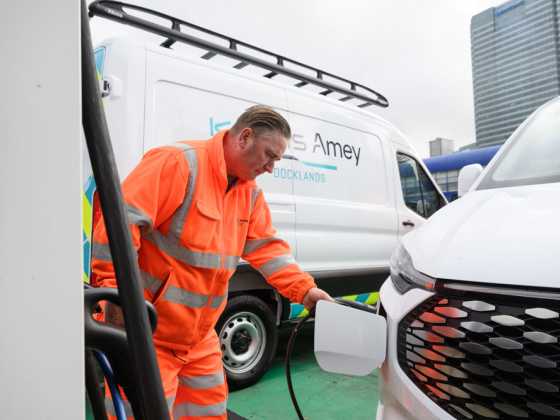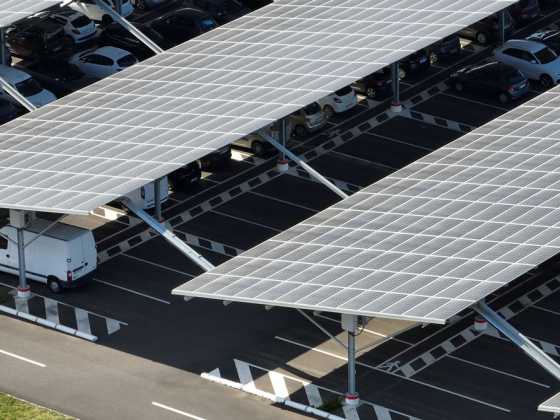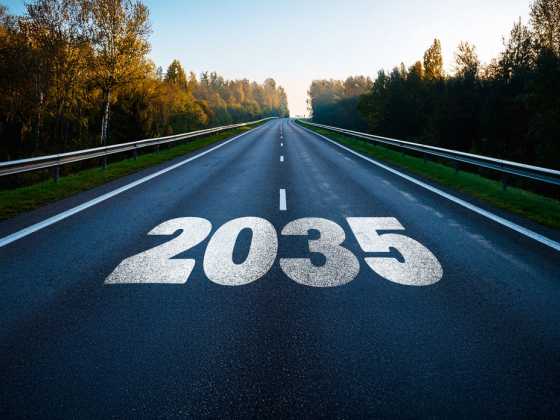Addressing common misconceptions about electric vehicles

While electric vehicles and the supporting charging infrastructure have developed rapidly in recent years, people still understandably have a lot of questions about this new technology. The government’s Office for Zero Emission Vehicles has therefore recently published a leaflet addressing common misconceptions about electric vehicles, explored here
The transition to electric vehicles (EVs) will be a crucial step to achieving the UK’s net zero target. The sale of new petrol and diesel cars will be phased out by 2030 and from 2035, all new cars and vans must be zero emissions at the tailpipe.
While EV technology, vehicles and infrastructure have developed rapidly in recent years, people still understandably have a lot of questions about this new technology.
OZEV has therefore created a leaflet addressing 19 common misconceptions surrounding EVs and EV charging infrastructure.
Cost concerns
A major barrier to electric vehicle adoption is the perception that they are too expensive. To this, OZEV say that EVs do cost more to buy outright but, in many cases, have a lower cost over four years. According to recent industry estimates, an EV can save £176 in running costs for every 1,000 miles driven. This means it can cost as little as 2 pence a mile to run an EV when charging on off-peak electricity. This is compared to over 20 pence per mile for petrol and diesel. As EVs have far fewer moving parts there’s also less maintenance to be done.
There are tax incentives in place for owners of EVs, including zero road tax and favourable company car tax rates. These can save some drivers over £2,000 per year. All this means that the market for more affordable zero emission vehicles is growing rapidly.
As of May 2022, 24 models are priced under £32,000 compared to 15 at the same time in 2021. With production costs reducing, some forecasts show that some EVs could be the same price to purchase as a petrol or diesel car well within the 2020s.
Range worries
Another significant issue preventing mass electric vehicle adoption is the fear that EVs do not have the battery range to travel as far as people need.
But the reality is that 99 per cent of car journeys in England are under 100 miles. This means most drivers’ needs are easily met by an EV.
For those travelling further, there are over 20 models available with a quoted 200-plus mile range. There are also some new electric cars coming soon with a range of over 300 miles, enough to get from Exeter to Leeds.
With battery prices having fallen to 80 per cent of what they were in 2010, continued price decreases in 2021 and further drops forecasted in the long term, OZEV expects to see more EVs available with greater range.
Environmental credentials
What about the greenhouse gas emissions generated while building an EV? Is it more than it saves? OZEV argues that this issue has been debunked in numerous well-respected studies.
A new battery-electric car has just a third of the lifetime greenhouse gas emissions of an equivalent new petrol car, even when taking into account battery production and disposal. EVs are getting progressively cleaner as electricity generation decarbonises.
Battery concerns
Another misconception about EVs is that their batteries will need replacing after five years. But the reality is that there are well over 10 million EVs on the world’s roads already. There is no evidence to suggest their lifespans are any different from a petrol or diesel vehicle.
Most EV batteries have warranties of around eight years (or 100,000 miles) but are expected to last much longer, and their lifespan continues to improve. EVs are in daily use across the UK’s roads as taxis and in other high mileage roles.
The government has committed £330 million to the Faraday Battery Challenge to support the research, development and scale-up of world-leading battery technology right here in the UK, including pioneering work on improving battery lifespan.
Another issue that some people raise is that batteries cannot be recycled and will all end up in landfill. But the OZEV leaflet points out that existing regulations ban the disposal of EV batteries to landfill and incineration. Car manufacturers are obligated to take back EV batteries free of charge and ensure they are treated at permitted facilities that meet the required recycling efficiency standards.
With the increasing number of EV batteries, OZEV is reviewing these regulations to strengthen them. The government’s £330 million Faraday Battery Challenge has an aim of increasing recyclability of an EV battery to 95 per cent by 2035, increasing the amount of minerals, like lithium and cobalt, that can be extracted and reused.
OZEV wants to create a circular economy for EV batteries to maximise the economic and environmental opportunities of the transition to zero emission vehicles.
Materials in batteries
Another concern that is often raised in arguments against electric vehicles is that the materials used in batteries come from questionable sources.
OZEV acknowledges that there are current challenges in ensuring the transparency and sustainability of materials used in batteries and electric motors. However, OZEV argues that this applies across many manufactured goods including smartphones and laptops.
The UK is part of international efforts to secure a transparent, sustainable and ethical supply of raw materials, protecting the lives and livelihoods of miners.
EV manufacturers are already committed to the responsible sourcing and reduction of ‘rare earth’ raw materials in their supply chains. They are also focusing on both transparency and security in their supply chain (for good business reasons) and on minimising the use of elements like cobalt and ‘rare earths’ in their designs.
Government is funding schemes to trial the recycling of key raw materials in batteries, and to localise more of the battery supply chain.
Some people also argue that there is not enough lithium to manufacture the batteries needed. To this, the OZEV leaflet says that there are more than enough global resources for EV batteries to meet the UK and global demands until at least 2050. Production will need to scale up in line with the increasing demand for EVs.
Recycling facilities and techniques are also improving to ensure a circular economy. Achievements in battery technology and chemistries are further decreasing pressure on resources.
Safety and breakdown concerns
Another concern sometimes raised is that EVs cannot be driven or charged in the rain.
This is not true; EVs have to comply with tough technical rules prior to entering the market, including crash and electrical safety. This means they are safe to drive and charge in a wide range of weather conditions.
Drivers should take the usual precautions by following the manufacturer’s instructions; only using the correct charging cable; and by checking the EV and cable are not damaged.
As with any vehicle, drivers should also consult the owner manual for guidance on the maximum depth of water a car is safe to drive through.
Is it true that EVs cannot tow or be towed? The OZEV leaflet says that like all other cars, electric vehicles need to be ‘type approved’ to tow a caravan or trailer. An increasing number of EVs are coming to market with this capability.
A caravan or trailer towed by an EV can also display a green number plate. When an EV is being towed by another vehicle at higher speeds and longer distances, many manufacturers require that they must be towed with the wheels off the ground. This is also the case for any automatic petrol and diesel vehicles, so this is not a new challenge for vehicle recovery companies.
If an EV breaks down and is in immediate danger (for example, when in a live traffic lane), it can be towed slowly a short distance to a safe location to await further assistance, just like any other vehicle.
Charging Infrastructure
A significant barrier to the uptake of electric vehicles is the concern that there are not enough chargepoints to meet demand.
OZEV says that the UK has one of the most extensive rapid charging networks in Europe, according to research.
Industry statistics show that there are over 31,000 public chargepoints available across the UK, a significant increase from 7,211 in 2017. There are also more than 5,800 rapid chargers.
What’s more, continued, accelerated deployment of public chargepoints is expected. On average, over 600 new chargers are being added to the UK’s road network each month, of which over 100 are rapid. Today, a driver is never more than 25 miles away from a chargepoint anywhere along England’s motorways and A-roads.
Most drivers charge at home and we expect to see this trend to continue. There are nearly 900,000 plug-in vehicles on UK roads and evidence suggests that those with off-street parking can meet the vast majority of their charging needs at home while their vehicles are parked.
The time it takes to charge an electric vehicle can put people off buying one. The OZEV leaflet says that most charging will be done at or near home overnight. However, some new cars can charge up 200 miles in as little as 20 minutes.
Potential charging speeds have increased by a factor of five in the past few years as businesses have started to focus seriously on EVs as the future of road transport.
Another concern is that EVs would only work for those with off-street parking.
OZEV says it wants to ensure that lack of access to off-street parking is not a barrier to realising the benefits of owning a plug-in electric vehicle.
The On-Street Residential Chargepoint Scheme (ORCS) is available to all UK local authorities (LAs) to provide public chargepoints for their residents without access to private parking. This year, £20 million is available under the scheme to ensure more LAs and residents can benefit. The scheme has supported over 150 different LAs to fund more than 11,000 chargepoints for residents who do not have off-street parking.
In March 2022, OZEV announced our £450 million local EV infrastructure (LEVI) fund. This will deliver a step-change in the rollout of EV infrastructure. This will focus on providing for households without off-street parking. OVEZ has launched a first tranche of £10m as a springboard for the development of the full fund, which closed to applicants on 17 June 2022.
The government’s £950m rapid charging fund (RCF) aims to future-proof electrical grid capacity at service areas on motorways and major A-roads to prepare the network for uptake of zero emission cars and vans ahead of need.
Rapid charging hubs and electric forecourts (equivalent to current petrol or diesel refuelling) are emerging as further options for EV drivers to recharge. Charging at workplaces is also growing. Government has supported the installation of over 26,000 workplace charging sockets as of April 2022.
Regional disparity
The patchy charging network is often cited as a reason for not buying an EV, with some saying that while there are lots of chargers in London, there are hardly any in other cities or in rural areas.
OZEV says that all regions in the UK have seen increases in publicly available chargepoints in the year to April 2022.
In addition to the ORCS scheme, government has also supported the installation of chargepoints in residential buildings and workplaces across the UK, including rural areas, through the EV Homecharge Scheme (EVHS) and the Workplace Charging Scheme (WCS).
London has received the second lowest number of grants per household in England under the EVHS and the lowest number of chargepoint sockets per person in the whole of the UK under the WCS.
Government will also be providing additional funding to install chargepoints for small accommodation businesses, which are disproportionately found in rural areas. This will help boost destination charging across the UK in such locations.
Another concern is that even when you get to a charge point, it could be broken.
OZEV says that EV users should expect a reliable public network wherever they drive in the UK.
Having chargepoints out of action is inconvenient, frustrating and can be unsafe. However, according to Zap-Map, nine out of ten chargepoints are working at any point in time.
OZEV says it is working to ensure that all consumers have a positive experience using the public charging network and any poor performing chargepoint operators are held to account. OZEV is mandating a 99 per cent reliability standard for rapid chargepoints in the UK and a free round-the-clock helpline for people struggling to charge. There will be legislation on this later this year.
The different apps and different types of connectors can also be off putting.
OZEV says that it will lay legislation later in 2022 to mandate payment roaming. This means chargepoint operators will have to work with each other to ensure that consumers can pay without having to download an app each time you use a different charging network.
This will also support the business sector to electrify their vehicle fleets. The govrernment legislated in 2017 to ensure all new and replacement public chargepoints must offer standardised connectors (plugs). This means that the vast majority of EVs can charge on the entire UK public charging network. The notable exceptions are the Nissan Leaf and Mitsubishi Outlander, which can charge at over 95 per cent of public chargepoints.
As manufacturers are increasingly standardising their connectors, government has no plans to intervene in the vehicle market.
Grid concerns
It is often raised that the grid will not be able to cope if everyone switches to EVs.
OZEV says that the Committee on Climate Change suggests that electrifying the vehicle fleet could result in road transport making up 15 per cent to 20 per cent of total electricity demand in 2050.
OZEV says it is confident the grid will be able to cope through the robust processes in place for bringing forward new generation and grid updates.
Government has given Ofgem, the energy regulator, legal responsibilities and powers to deliver an energy system fit for both current and future consumers. OZEV is also ensuring that Ofgem considers our energy policy priorities for delivering net zero in its regulatory decisions.
Smart charging is an important part of this process. Smart charging technologies allow EV charging to take place when demand for electricity is lower. For example, at night or when there is lots of renewable energy on the grid.
This reduces electricity system costs, lowering prices for everyone. The motorist pays less for charging their EV and the electricity powering the EVs is greener.
Another concern is that EVs are not actually ‘greener’ because of emissions from electricity generation.
OZEV says that since 1990, the UK has reduced greenhouse gas emissions in its electricity system by over 70 per cent. Taken together, renewables and other low carbon generation, such as nuclear, currently provide over 50 per cent of our electricity.
The government continues to support the deployment of low carbon and renewable technologies to deliver a cleaner greener system at least cost to consumers and that maintains a secure supply of electricity.
The government plans could see 95 per cent of our electricity come from low carbon sources by 2030. By 2035, all our electricity will come from low carbon sources, subject to security of supply.
There are also concerns about laying more cables. OZEV says that Ofgem ensures that electricity network companies are funded to meet the additional demand from EVs.
This incentivises them to plan and deliver the work as efficiently as possible. This includes minimising unnecessary disruption and expense, for example by laying larger cables to avoid reopening roads twice.
What about hydrogen
And what about hydrogen? Could you not just easily switch all petrol and diesel cars to burn hydrogen without going to all this trouble?
OZEV points out that the government remains technology neutral. However, currently combustion hydrogen in a conventional engine still produces nitrogen oxide (NOx) and some CO2 exhaust emissions. This means that for now it is not zero emissions.
By comparison, the only exhaust emissions from hydrogen fuel cell vehicles is water. As set out in the government’s hydrogen strategy, OZEV expects hydrogen to play a significant role in decarbonising transport. OZEV expects it will probably be most effectively used in heavier transport applications ‘that batteries might not reach’ like large trucks, maritime and aviation.
For cars and vans, battery electric technology is the chosen route for a clear majority of manufacturers and motorists.
See the OZEV leaflet here.






